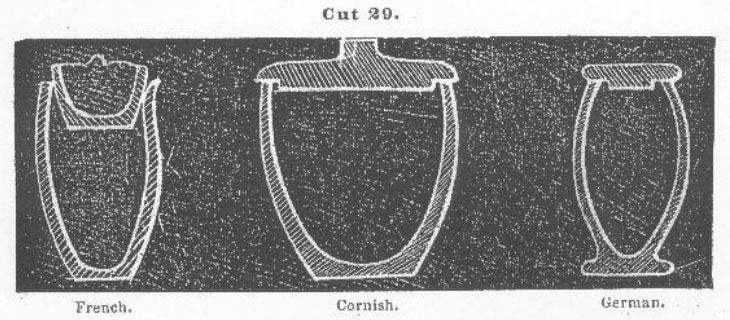Copper Mining
- Copper Mining and Smelting – History
- Copper Mining
- Copper Smelting Technology – From South Wales to New South Wales.
- Lentin’s description of copper smelting in Anglesey in 1800
- Ure’s description of the smelting process at Swansea, 1861
- The six stage smelting process used at Cadia in 1861
- South Australia – The Copper Kingdom.
- Kapunda
- Burra
- Wallaroo, Moonta and Kadina
- The Bon Accord Mine, Burra, South Australia
- Copper mining in New South Wales before 1860
The six stage smelting process used at Cadia in 1861

The three types of crucible used in assaying copper in the 19th century. Examples of the Cornish crucible have been found at Cadia (The Explorers’, Miners’ and Assayers’ Companion, William Dymock, Sydney, 1887: 303).
The Wandering Reporter for the Sydney Mail outlined the processes for Smelter No. 1 at Cadia on 16 September 1865.
“The first process to which the ore is submitted is that of calcining, by which the water and some of the earthy particles are removed. The second is smelting the calcined ores, by which a large portion of the siliceous matter is taken out, the remainder forming with the iron into a slag that has been found to be a valuable flux for the richer ores. The third process is the melting of the results of No. 2, which gives a regulus of about 45 per cent., with the best carbonate of oxide ores, containing themselves a per-centage of from 20 to 30 of copper. This brings on the metal to about 60 to 65 per cent., and it then undergoes the fourth process by being charged into the wasting furnace, by which it is brought up to about 80 per cent. By the fifth process it is returned in blocks to the roasting furnace, where it is roasted into copper of about 98 per cent. The sixth and last process is charging the process of No. 5 into the roasting furnace, where it is converted into pure copper of standard quality. In this last instance, the charge is usually about 8 tons, and the process occupiers twenty-four hours. In the calcining furnace about 40 to 60- tons a week are roasted and prepared for the subsequent operations, the quantity of course decreasing as the various operations are gone through. The quantity of ore smelted is usually about 200 tons per month, and this gives a monthly yield of about thirty tons of pure copper, being at the rate of from 15 to 16 per cent. The smelting is all done with wood for fuel, and for the above quantity of ore no less than 1200 tons of firewood are consumed.”
The processes may be summarised as follows:
- Calcining.
- Smelting to provide a matte or regulus of 45% pure copper.
- Smelting with carbonate of oxide ores to produce a matte of 60 to 65% copper.
- Wasting furnace, smelting to about 80% purity.
- Roasting furnace, smelting to about 98% purity.
- Roasting furnace, smelting to pure or standard copper.
It is possible that processes 2 and 3 were undertaken in the same furnace, so that the ore was taken from the calcining furnace to a smelting furnace, to a wasting furnace and finally to the roasting or refining furnace.
The processes used at Cadia are similar to those used in Swansea, South Wales, as described by Ure. They are compared as follows:
- Calcining of the ore.
- Fusing of the calcined ore.
- Calcining of coarse metal. This process appears not to have been undertaken at Cadia.
- Melting of calcined coarse metal.
- Calcining of fine metal (second matte). Again not undertaken at Cadia.
- Melting calcined fine metal. Again not undertaken at Cadia.
- Roasting coarse copper to produce blister copper.
- Refining or toughening the copper.
Ure indicated that processes 5 and 6 could be omitted and this is certainly what happened at Cadia, with the ingots produced in process 4 going straight to the roasting and refining processes 7 and 8. It is also apparent that process 3 seems to have been omitted at Cadia, indicating that by 1865 the more complex smelting processes for pyritic ores were not yet required. They were smelting sulphide, mixed with carbonate ores as a flux. The carbonate ores were located nearer the surface and probably the mining at Cadia had not yet encountered the pyritic ores usually found at greater depths. The pyritic ores would certainly have required initial roasting and calcining and probably the inclusion of process 3.